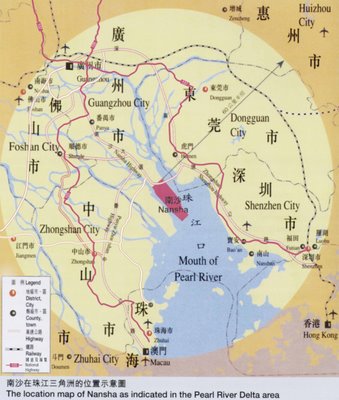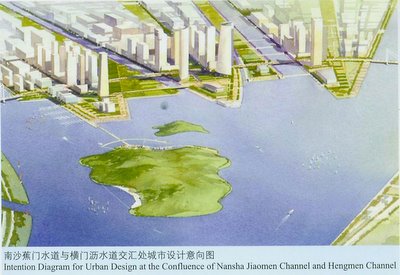Chinese Industrial Parks

The “preconference” part of this past week’s 3rd China Planning Network conference involved a visit to the Nansha planning district of Guangzhou in the red hot Pearl River Delta last weekend. Nearly halfway, as the crow flies, between Guangzhou and Hong Kong, these islands and agricultural pennisulas just opposite Shenzhen are in the midst of a transformation to a major port/IT/industrial park.
How major? The important port of Guangzhou is being moved in its entirety and then expanded by some large integer multiple to include 60 deep sea ports in total. (I’d show you a picture of the port operations as they stand, but no photos permitted, please.) Two automobile plants (Toyota and Honda) for domestic markets are already in operation. Several elevated rail systems are under construction to link worker housing with work sites. And they are just getting started. While there are plans for upmarket nonworker residential housing (and yacht docks!), most residents are expected to work in adjacent sites. Since these industries are not particularly labor intensive, a modest population of 500,000 is planned. Note that the larger Guangzhou metropolitan area has something on the order of 20 to 30 million residents, depending on where you draw the lines on the map.
By the way, we learned there that the government had banned further construction of single family suburban housing throughout urban China, just within the last couple of months. I don’t know what this means exactly, however. Do you?

The “foreign experts” in our group (Z. Peng, UW Milwaukee; M. Shiffer, UIC & CTA; J. Kayden, Harvard; A. Kim and L. Vale, MIT; yours truly) were asked to comment on the Nansha plans, with the caveat that these were only initial, relatively uninformed reactions to a quick tour and short presentations.
Kayden suggested much stronger promotion of the design attractions of the proposed residential developments, perhaps capitalizing on the many Venice-like canals of the area. We then wondered about the “green” rhetoric of the plan (given the tremendous pollution problems associated with US ports), the threat of weather (the area is subject to typhoons), the viability of rail transit, the realism of expecting virtually all workers to live near work (in a new China where more and more urban workers can afford cars and live where they like), and interjurisdictional coordination issues.
For example, a Shenzhen official attending the meeting asked how the Nansha ports would compete with his ports just across the river, and whether a USA-style MPO to overview things regionally might be in order. (No! Instead we proposed joint powers authority-type agreements, at least to start. It was also mentioned that the market might well support both ports, where competition might then have benefits all around. Still, it was interesting that they didn’t seem to be talking outside this forum.) There was also explicit discussion of the role of a private Hong Kong developer important in the area in mediating/negotiating these changes with current farming communities, as an intermediary with the government. We weren’t advising so much as brainstorming.

A key impression was that these plans are mainly about providing infrastructure that can support high levels of sustained growth in trade and other economic activity over an extended period. These were polished, detailed, long-term and largely thoughtful plans, heavy on design- and engineering-oriented investments to remove obstacles to growth.
At the same time, while the promotional materials also highlight “social” and “ecological” sustainability, it was unclear what either meant in practice or over the longer term. And these are clearly very stimulating or risky investments, depending on market demand for imports and exports in the area.
Still, as often seems the case in the growing parts of urban China, it is hard not to be a bit overwhelmed by the scale, pace and confidence of these plans. If interested further, as I am, it is probably worth the effort to find this new book based on a Harvard design studio of the same: A. Berger and M. Crawford, eds. (2006) Nansha Coastal City: Landscape and Urbanism in the Pearl River Delta, Harvard University Graduate School of Design.

- Published:
- Sunday, June 18th, 2006
- Author:
- randall Crane
- Topics:
- China
Blogroll
- Becker-Posner blog
- BLDG BLOG
- Burb
- CityStates
- Curbed LA
- Cyburbia
- DemocraticSPACE
- Environmental and Urban Economics
- Freakonomics
- LA Transportation Headlines
- Peter Gordon’s Blog
- Planetizen
- The Center for Land Use Interpretation
- The Transportationist
- the urban commons
- This week’s finds in planning
- Urbanicity
Journals
- Cityscape
- environment and planning a,b,c,d
- Harvard Design Magazine
- Housing Policy Debate
- Housing Studies
- International Development Planning Review
- International Journal of Urban and Regional Research
- International Regional Science Review
- Journal of Architectural and Planning Research
- Journal of Housing Economics
- Journal of Planning Education and Research
- Journal of Planning Literature
- Journal of Regional Science
- Journal of the American Planning Association
- Journal of Urban Affairs
- Journal of Urban Economics
- Planning Theory
- Regional Science & Urban Economics
- Transportation Research Parts A,B,C,D,E,F
- Urban Studies
- World Development
Comments are closed
Comments are currently closed on this entry.